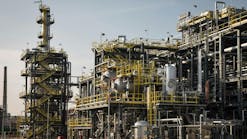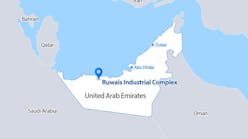PKN Orlen advances new visbreaking, other projects at Plock refinery
Polski Koncern Naftowy SA (PKN Orlen) has started construction on its previously proposed and recently approved project to add a new visbreaking unit at its 327,300-b/d integrated refining and petrochemical complex in Plock, Poland (OGJ Online, Feb. 27, 2020; Dec. 2, 2019).
The new 1-billion zloty visbreaking unit, on which construction began in early July, aims to improve crude feedstock flexibility and efficiency by increasing the yield of light, high-margin products such as gasoline and diesel via in-depth conversion of vacuum residue from the refinery’s crude distillation unit, PKN Orlen said.
Scheduled to be completed in 30 months, the new visbreaker—which will enable the refinery to increase its yields of fuel from every barrel of oil processed by several percentage points—should be ready for commissioning in December 2022, according to the operator.
“We are implementing the visbreaker project because we want to effectively respond to the growing demand for high-margin products. The unit will allow us to optimize refining output and quickly grow our profits. It will also increase the yield of fuels from crude processing by 2% and drive up EBITDA by as much as 415 million zloty annually,” said Daniel Obajtek, president of PKN Orlen's management board.
To date, the refinery has used the vacuum residue that will be processed by the new visbreaker to produce lower-margin products, including heavy fuel oil and asphalt.
PKN Orlen did not disclose a capacity of the planned visbreaker, but the operator once again said the unit will be equipped with an unidentified visbreaking technology jointly licensed by Royal Dutch Shell PLC and McDermott International Inc. (formerly CB&I Nederland BV). While OGJ research based on information available from both Shell and McDermott’s websites indicates the only historical, jointly licensed visbreaking technology offered by the companies was the Shell Soaker Visbreaking technology, McDermott confirmed to OGJ earlier this year that the visbreaking technology licensing partnership with Shell was terminated in March 2019 (OGJ Online, July 27, 2015).
PKN Orlen previously let a 750-million zloty turnkey contract for design, procurement, construction, installation, commissioning, and start-up services for the new visbreaker to a consortium of KTI Poland SA and IDS-BUD SA.
Additional projects under way
Concurrently with construction of Płock’s visbreaking unit, PKN Orlen said it also is executing two additional projects at the site to improve operations. These projects include an upgrade of the refinery’s hydrocracking unit that, once completed, will increase diesel production by 100,000 tonnes/year, as well as a separate project to modernize a diesel hydrotreater at the refinery that will boost diesel production by 150,000 tpy.
Scheduled to be completed in late 2020, the hydrocracking and hydrotreating projects are slated to add 200 million zloty to total annual EBITDA, the company said in February 2020.
PKN ORLEN said it expects that after 2022—once all investment projects currently under way at the Płock refinery are completed—the company’s annual EBITDA will grow by more than 600 million zloty.
As part of PKN Orlen’s Petrochemicals Development Programme (PDP)s—which aims to position the company to take full advantage of its potential in petrochemicals by adding some 30% to the operator’s existing capacity while ensuring a marked improvement in Poland’s overall trade balance in petrochemicals—the company said it also is advancing work on its proposed Plock Research & Development Center (R&D Center) to develop, improve, and patent new and existing technologies, licenses, and products.
Intended to help reduce and eliminate PKN Orlen’s need to purchase external technologies, the R&D Center will include modelling and pilot plants and advanced research labs that will allow the company to test new technological solutions and products before applying them in its own operating units.
Launched in 2018 and requiring an estimated investment of about 8.3 billion zloty, the PDP—which will be implemented through yearend 2023—will result in an additional EBITDA of more than 1.5 billion zloty/year upon its completion, PKN Orlen said.
PKN Orlen previously has let a series of contracts for PDP projects at Plock (OGJ Online, May 13, 2020; Feb. 26, 2020; Sept. 13, 2019).

Robert Brelsford | Downstream Editor
Robert Brelsford joined Oil & Gas Journal in October 2013 as downstream technology editor after 8 years as a crude oil price and news reporter on spot crude transactions at the US Gulf Coast, West Coast, Canadian, and Latin American markets. He holds a BA (2000) in English from Rice University and an MS (2003) in education and social policy from Northwestern University.



